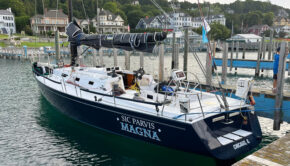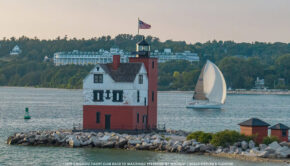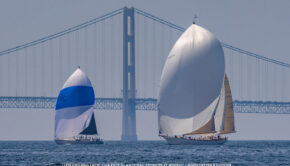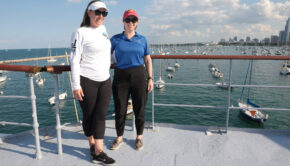Brutal Test, Subdued Celebration
Published on July 31st, 2018
The Chicago Mackinac Race continues to deliver a test that rivals any in our sport. Rich Sterns shares his experience this year with J/Boats News:
The flags on Mackinac Island are at half-mast again. Another sailor has died from the fury of Lake Michigan. Five years ago, a squall packing winds over 100 knots ripped through the fleet, killing two sailors. This time it was just the raw power of Lake Michigan.
There are so many ways to enjoy the sport of sailboat racing. Big boat, little boat, Buoy racing and more. Unlike many sports that want to tell everyone they are extreme, sailing is just the opposite. We revel in the beauty of working with and against Mother Nature and marveling of the beauty of it all.
Sailing is often a serene, almost boring sport, but distance racing always has the possibility of being one of the most extreme sports in the world. The fact that you don’t know exactly when it is going to turn extreme compounds the danger.
The forecast for the race was rough. The Coast Guard and weather people at the skippers meeting warned that conditions were bad and suggested it may be worth each boat considering if it would be too much for their boat and crew.
Many people in the world and even the U.S. don’t understand how big the Great Lakes are and how violent the lakes can be. It is hard for many to imagine a fresh water lake such as Lake Michigan that is over 300 miles long, 90 miles wide, and a thousand feet deep in some areas, with 1,000,000,000,000,000 gallons of water in it (that is 1 quadrillion gallons). Shipping gets shut down in the winter partly by ice, but partly because of the rough conditions.
To attest to the fury they can bring, there are thousands of sunken ships scattered in the bottom of the Great Lakes. A 12-foot wave on the ocean is big, but they are spread apart, they are swells. On the lake, the 12-foot waves come at you and they are spaced roughly 100 to 120 feet apart. They were not all 12 to 15 feet, but they were relentless. Remember, the 730-foot Edmond Fitzgerald got broken in half by Lake Superior.
On the morning of our start, the gale was building and near gale force winds would continue for 18 hours and even when it dropped to below 20 knots the next day, the conditions were tough and 18 knots seemed light.
I sailed a modified J/109 “TOA” for the second year. Last year we were the overall winner of the race. We started with a reefed main and a #3 jib. Our start was at noon; it was a beat with port tack favored and the fleet headed Northeast towards the Michigan shore. The rhumbline is 200 miles at 18 degrees to Point Betsie on the Michigan shore. Then, you continue to the Manitou passage.
We had three crew that got sick for a while and one that would stay sick for the next 48 hours. However, other boats had many more. I estimate 1/2 of the sailors got sea sick of varying severity and over 60 boats dropped out.
Once underway, the J/109 did very well in the waves. Every so often, a good load of blue water would pound he boat and soak the crew, but the water was warm and, of course, being fresh made it slightly less miserable. There was intermittent rain just to make sure we didn’t get too comfy.
By nightfall, we were in first place in our section and 3rd overall. By that time we were over half way across the lake, there was a small wind shift, so boats started tacking to starboard into the middle towards the Wisconsin shore. With all the crew on the rail (less one), we pounded our way north.
At night, it is easy to go slow and not realize it. In those conditions, you are reefed and the jib is on an outboard lead to keep the helm under control. It is hard enough to sail in big seas, but at night with 30 knots and rain and no boats to steer off in front, it is easy to sail the boat slow.
When I sailed it was useful to light up the telltale on the stay to make sure I didn’t steer way to low. When you steer high you luff, but steering too low, you don’t get the power sensation since you are so de-powered. We did not have good apparent wind numbers and that could have been our downfall.
Sometime during the night, we lost our 2-mile lead and lost another 3 miles. In hindsight, we sailed a persistent knock for too long and missed a 15-degree wind shift. We sailed the starboard tack until 4:30 in the morning. Then, we tacked towards the Michigan shore again.
Twenty-four hours into the race, it was still a beat. We were on the Michigan shore near Big Sable point and we had dropped to third. The reef was out, it seemed like we were sailing well, but we were falling further behind the two leaders.
Winds continued to diminish throughout the night, but we remained on a beat. We were treated to a spectacular rainbow/moon combination before sunset, which lasted for over an hour before the sun finally disappeared.
At 2:30 am beginning the third day, we entered the Manitou Passage. By that time, the wind had lightened up considerably to around 13 knots. We were still on a beat and in the passage, but you are well protected from the waves by the Manitou Islands. Earlier in the race, we knew we were behind because we had had cell phone coverage. We were able to check again and found out we were back in second.
It is about 80 miles from the entrance of the Manitou Passage to Grey’s Reef lighthouse. Given the change in angle of the course we thought we might have more of a reach. Sadly, the wind shifted and we were still on a beat. The winds continued to lighten as we approached daybreak. We were entertained by a spectacular fog show. The fog just rolled in near land and as we left it, you could see tops of the sails of our competitors above it looking like shark fins.
By the time we got to the lighthouse at Grey’s Reef, the wind had died. We had a Code 0 up to “beat” to the lighthouse. In the Grey’s Reef passage, you have Islands to port and Michigan to starboard. It opens up to fairly big area maybe 15 miles wide. It would just be our luck to have the light air turn into a beat to get around “can 3” which is a few miles up the reef.
After the can, you take a 90-degree turn into the Straits of Mackinac. Once again, the wind shifted and it turned into a light air beat. The Straits are 20 miles to the Mackinac Bridge. It was light and boats played both shorelines. We chose the North side, it turned out a northerly came in, and we could put a spinnaker up and creep to the Bridge.
With a mile to go to the bridge, the wind stopped again, and we used the wind seeker to get under the bridge. The wind seeker is a cool sail, it goes up the forestay and is super light, and it is fully battened with really light battens. It is amazing how well it takes shape in no air. The beating continued under the bridge to the finish line. After 60 hours, the race was over.
There were parties and seeing friends at the bars, but the fact a fellow sailor had died in the race, and the flags were at half-mast, subdued the celebration, as we all realized it could have been any of us.
Event details – Results – Tracker
Background: The 110th edition of the race attracted 288 boats across the Racing and Cruising Divisions for the 289.4 nm course from the Chicago Lighthouse, just off Navy Pier, to Mackinac Island. The Cruising Division had 43 boats starting July 20 and the balance in the Racing Division, which included Imedi, started July 21.









 We’ll keep your information safe.
We’ll keep your information safe.